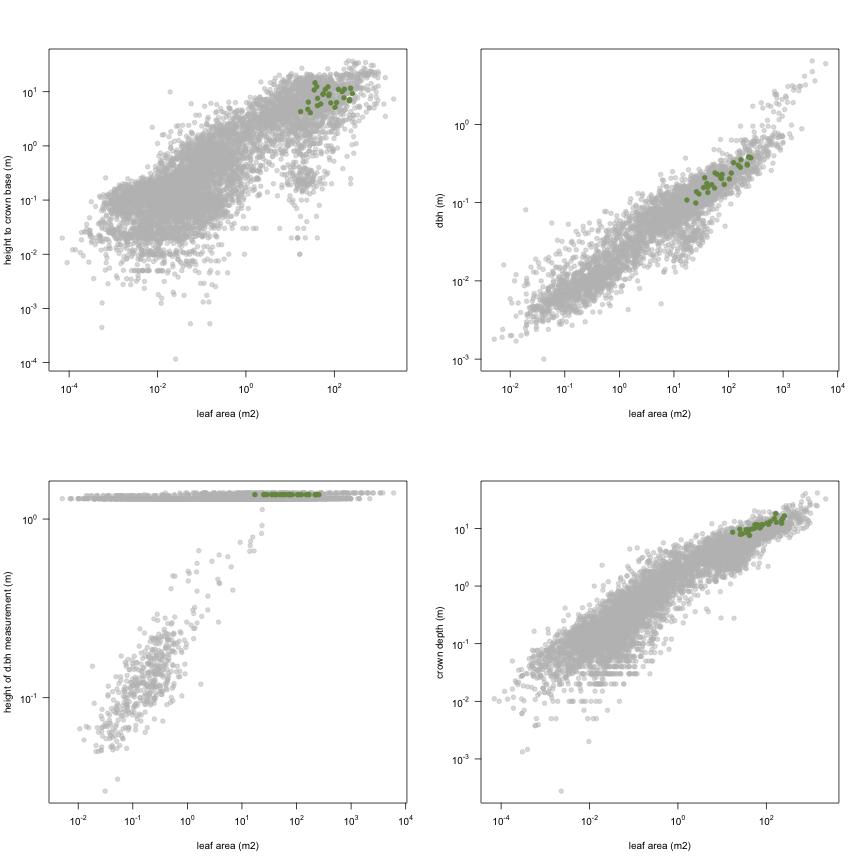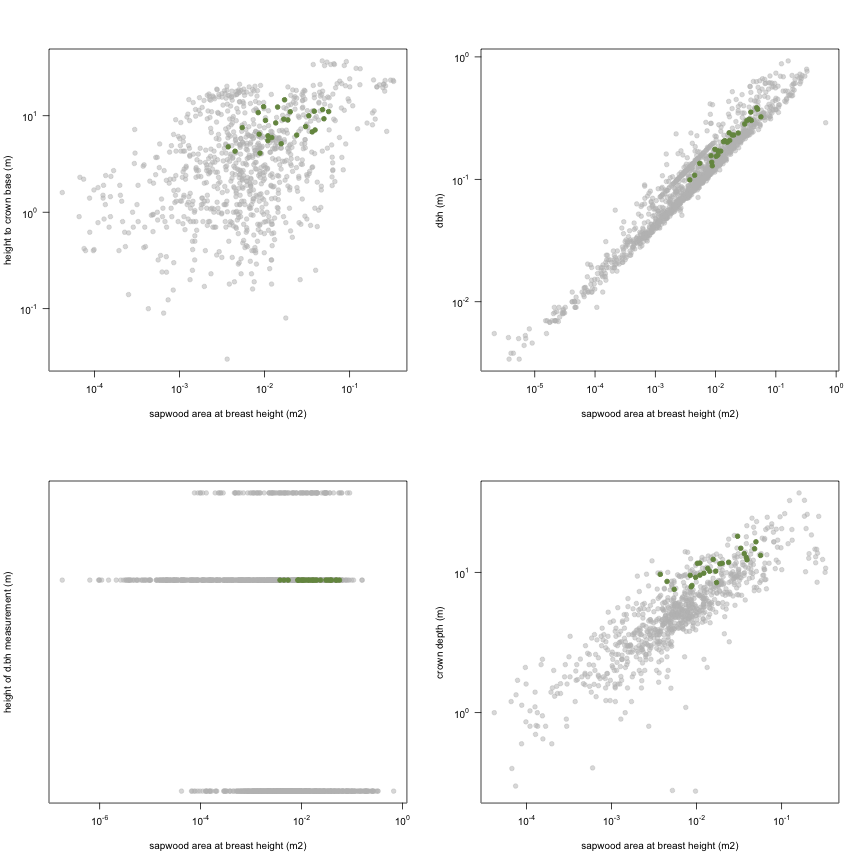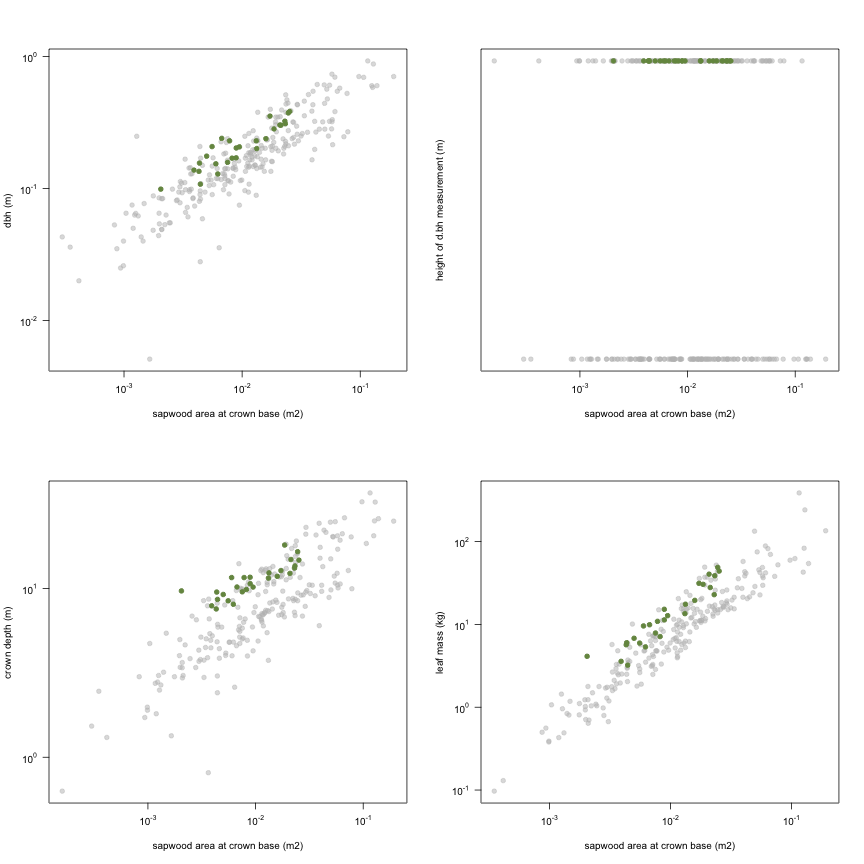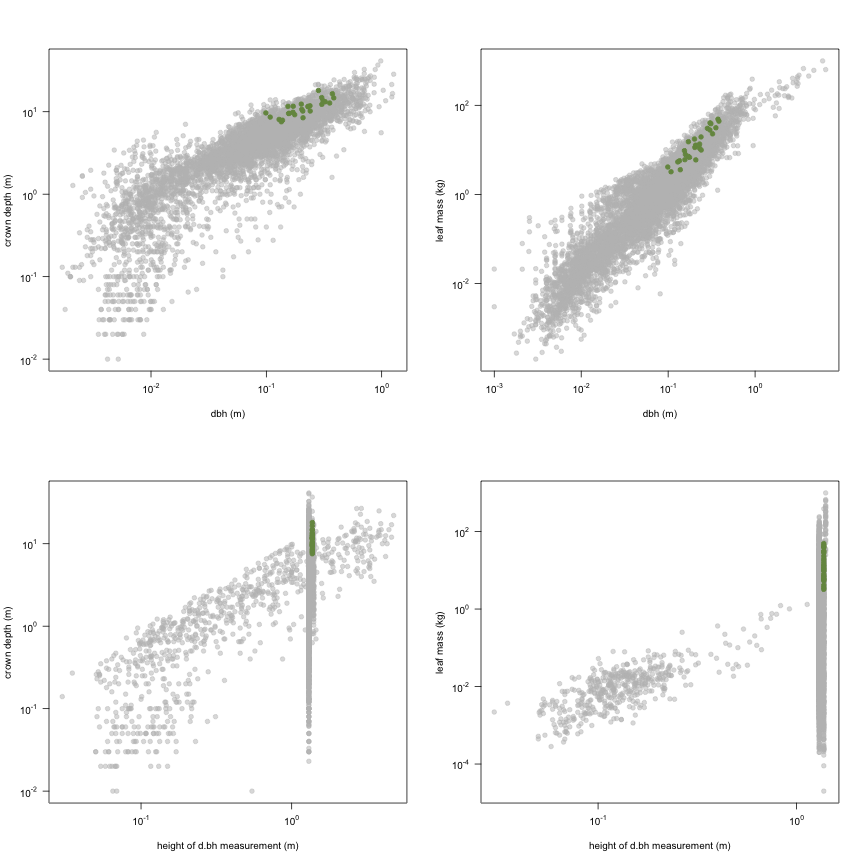-
Notifications
You must be signed in to change notification settings - Fork 19
Roeh1997
Data contributor: Douglas A. Maguire
Email: [email protected]
Address:
- Department of Forest Engineering, Resources and Management, Oregon State University, Corvallis OR 97331-5752, USA
Citation: Roeh RL and Maguire DA (1997). 'Crown profile models based on branch attributes in coastal Douglas-fir.' Forest Ecology and Management, 96(1-2), pp. 77-100.
DOI: 10.1016/S0378-1127(97)00033-9
Abstract: Crown size and crown dimensions are important variables for imparting biological realism to individual-tree growth models. Models for estimating crown profile in Douglas-fir (Pseudotsuga menziesii (Mirb.) Franco) were developed from attributes of individual whorl branches, including basal diameter, total length, angle of origin, and height from ground. The prediction system consisted of four equations to predict whorl branch basal diameter, branch length, branch angle of origin, and corresponding crown radius. The system is entered with three standard individual tree measurements: diameter at breast height ({DBH)}, total height, and height to crown base. Four approaches were developed for modeling crown profile with this system of equations, distinguished by parameter estimation method, modeling data subset, and the specific form by which whorl branch diameter was represented (mean vs maximum diameter). A system-of-equations parameter-estimation technique (modified three-stage least squares) was applied to account for the correlation of error terms across the equations, and this procedure was compared with ordinary and nonlinear least squares methods. The resulting crown profile prediction systems were evaluated under both theoretical and empirical criteria. The recommended system appears to perform well against validation data on both an equation (branch) level and system (crown profile) level.
The dataset includes records for 27 individuals from 1 species belonging to 1 family(ies), presenting 1 functional type(s), growing in 1 condition(s) within 1 major type(s) of habitat, with data included for the following variables:
| Variable | Label | Units | N | Min | Median | Max |
|---|---|---|---|---|---|---|
| latitude | Latitude | deg | 27 | 46 | 48 | 49 |
| longitude | Longitude | deg | 27 | -124 | -123 | -122 |
| a.lf | Leaf area | m2 | 27 | 17 | 72 | 257 |
| a.ssbh | Sapwood area at breast height | m2 | 27 | 0.0037 | 0.016 | 0.057 |
| a.ssbc | Sapwood area at crown base | m2 | 27 | 0.002 | 0.0089 | 0.025 |
| a.stbh | Stem area at breast height | m2 | 27 | 0.0077 | 0.034 | 0.12 |
| h.t | Height | m | 27 | 12 | 20 | 26 |
| h.c | Height to crown base | m | 27 | 4.1 | 8.4 | 15 |
| d.bh | Dbh | m | 27 | 0.099 | 0.21 | 0.38 |
| h.bh | Height of d.bh measurement | m | 27 | 1.4 | 1.4 | 1.4 |
| c.d | Crown depth | m | 27 | 7.6 | 12 | 18 |
| m.lf | Leaf mass | kg | 27 | 3.2 | 11 | 49 |

And locally within the country:


The sites sampled are:
| Location | Longitude | Latitude | Vegetation |
|---|---|---|---|
| Ostrander Road, Kelso, WA, USA | -122.900 | 46.200 | Temperate forest |
| Pilchuck Bridge, WA, USA | -121.900 | 48.300 | Temperate forest |
| Elk Creek | -124.200 | 48.700 | Temperate forest |
| Robertson Main | -123.063 | 46.054 | Temperate forest |
The growing conditions of sampled plants was:
| Location | Grouping | growingCondition |
|---|---|---|
| Ostrander Road, Kelso, WA, USA | Installation = 704; Plot = 3 | plantation managed |
| Ostrander Road, Kelso, WA, USA | Installation = 704; Plot = 4 | plantation managed |
| Pilchuck Bridge, WA, USA | Installation = 805; Plot = 1 | plantation managed |
| Pilchuck Bridge, WA, USA | Installation = 805; Plot = 2 | plantation managed |
| Elk Creek | Installation = 806; Plot = 1 | plantation managed |
| Elk Creek | Installation = 806; Plot = 4 | plantation managed |
| Robertson Main | Installation = 810; Plot = 1 | plantation managed |
| Species | Family | Pft |
|---|---|---|
| Pseudotsuga menziesii | Pinaceae | evergreen gymnosperm |
Sampling strategy: From each plot, nine to ten undamaged trees were selected for intensive crown measurements.
Leaf area: Unknown
Stem cross sectional area: From diameter at breast height to the nearest 1mm
Height: Total tree height to the nearest 0.02m
Biomass: Unknown
Traits: Unknown
Growth environment: Managed plantations established by the Stand Management Cooperative.
This is how the study Roeh1997 fits in the entire dataset (grey). each colour represents a species. A legend of species names with colours is included at the end for reports with 1 < n < 20 species.











